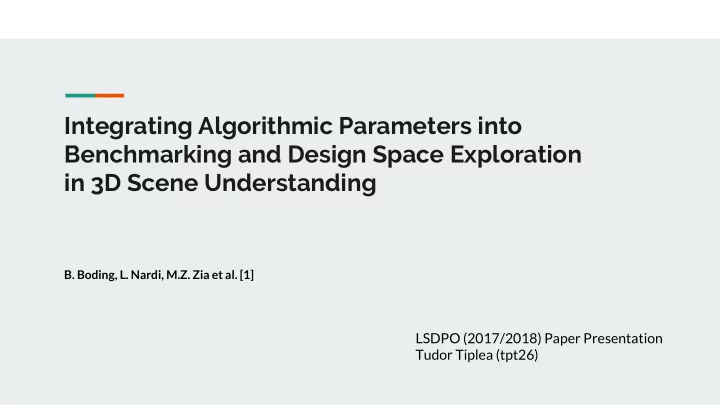

Integrating Algorithmic Parameters into Benchmarking and Design Space Exploration in 3D Scene Understanding B. Boding, L. Nardi, M.Z. Zia et al. [1] LSDPO (2017/2018) Paper Presentation Tudor Tiplea (tpt26)
Problem Many modern systems must operate under increasingly more severe constraints ● E.g. tight power consumption and thermal footprint constraints for mobile systems ○ How can we help system designers make informed trade-off decisions ? ● E.g. balance performance/accuracy of a system under a power consumption < 1W constraint ○ And how can we automatically optimise the system as much as possible? ●
Specific problem Demonstrate on a concrete application, a 3D scene understanding algorithm ● High computational demands ○ We can configure the system at the algorithmic , compiler and architectural level ● Usual approaches only focus on the last two ○ Measure performance in terms of power consumption , runtime (FPS) and accuracy of ● computation
Goal We want to identify the Pareto optimal ● front in the optimisation space These are the solutions that cannot be ● improved in any optimisation objective without degrading at least another objective
Performance model 1,800,000 possible configurations ● Cannot explore exhaustively ● Therefore, a model predicting the ● performance of a configuration must be built
Active learning Can bootstrap a predictive model using active learning: ● Start with a random sample of configurations ○ Run the system with the sampled configurations ○ Measure the runtime, accuracy and power consumption ○ Train predictor using all the datapoints we’ve evaluated so far ○ Estimate Pareto optimal front using current predictor ○ Sample a new set of configurations localised in this new estimated area ○ Iterate ○ In other words, use predictor to pick training examples that improve its accuracy the most ●
Randomised Decision Forest In this case, a better predictor than neural networks, SVMs and nearest neighbour ● A decision tree is a recursive binary partitioning of the input space: ● A simple decision (1D threshold) at each internal node ○ Output of a leaf is average of training samples that reached that leaf ○ A randomised decision forest is a collection of decision trees: ● Output is average of outputs from each decision tree ○ Introduce randomness to remove variance in training: ○ Train each tree on random subset of training data ■ For each node, pick decision input variable randomly (e.g. volume resolution parameter) ■
Example: Binary Decision Tree
Step back - Co-design space exploration Follow an incremental, top-down approach: ● Start with random sample of configurations ○ Estimate Pareto optimal front in the algorithmic level ○ Refine that at the compiler level ○ Refine even further at the architectural level ○
Results Greatest improvements gained at algorithmic level (6.35x improvement in execution time, ● 23.5% reduction in power consumption) Further improvements at lower levels, but of smaller magnitude ● Reached goal of running the 3D mapping in real time , on an embedded device with a 1W ● power budget 4.8x execution time and 2.8x power consumption reductions over hand-tuned, ● state-of-the-art implementations of the 3D mapping algorithm
Opinion Shown that exploring algorithmic level is worth it for optimising a system ● But the approach doesn’t give the same impressive results at the lower levels ● This methodology was developed with this application in mind, no guarantee it would work ● well out of the box for other applications
Questions Thank you!
References [1] B. Bodin, L. Nardi, M. Z. Zia et al. ‘ Integrating Algorithmic Parameters into Benchmarking and Design Space Exploration in 3D Scene Understanding’ All figures, plots and tables in this presentation are extracted from the paper above.
Recommend
More recommend